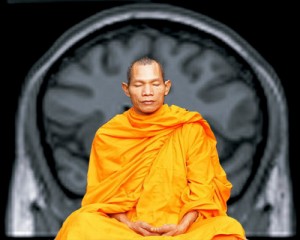[retweet][facebook]
All the more reason to attend my free meditation class!
Individuals with no experience in meditation who participate in mindful meditation training sessions for as little as 4 days show changes in specific brain mechanisms that correlate with a reduction in anxiety, a new imaging study shows.
“There is plenty of evidence that meditation can improve a host of issues, such as pain and cognitive function, and anxiety is perhaps at the top of the list,” explained lead author Fadel Zeidan, PhD, a postdoctoral research fellow in neurobiology and anatomy at Wake Forest School of Medicine, in Winston-Salem, North Carolina.
“But what we’ve been able to do is to correlate, through imaging, changes in specific brain regions that are related to anxiety, even in a cohort of people with no anxiety or depression.”
For the study, Dr. Zeidan and his colleagues recruited 15 healthy volunteers with normal levels of anxiety and no experience in meditation to participate in 4 20-minute training sessions to learn the technique for mindful meditation.
This involves a focus on breathing and a conscious acknowledging of distracting thoughts and emotions, combined with a decision not to react to them.
“You’re trained to focus on keeping a very straight posture and the sensations of the rise and fall of your chest and abdomen as you breathe,” Dr. Zeidan explained.
“If your mind becomes distracted, you acknowledge the distraction, let it go, and focus back on the breathing. You are regulating your emotional responses.”
Before and after each meditation training session, the participants, who included graduate students and faculty, received brain activity imaging with pulsed arterial spin labeling magnetic resonance imaging (MRI).
The participants also were administered the State Anxiety Inventory, a 20-item subscale of the State Trait Anxiety Inventory, before and after the brain imaging.
While the participants reported meditation-related reductions in anxiety ratings by as much as 22%, the MRIs showed anxiety relief to be associated with activation of the anterior cingulate cortex and ventromedial prefrontal cortex (vmPFC), which show decreases in activity when anxiety is present.
The vmPFC is also implicated in the alteration of contextual evaluation of affective processes, the authors write.
“Activation in the vmPFC is associated with modulating higher-order affective appraisals, including cognitive regulation of negative emotions.”
In addition, reports of greater anxiety correlated with greater default-related activity (ie, posterior cingulate cortex) on MRI, “possibly reflecting an inability to control self-referential thoughts,” the authors write.
The brain mechanisms related to the reduction of anxiety through mindful meditation in healthy people have never been identified, so the findings help confirm that the changes do occur, said Dr. Zeidan.
“It shows that mindful meditation can be sort of this buffer to anxiety. After just a brief training, you can reduce this ruminative thought process, change your attention, and change the context in how you respond to things,” he said.
Potential Payoff
Amit Sood, MD, director of research and practice in the Mayo Complementary and Integrative Medicine Program at Mayo Clinic, in Rochester, Minnesota, said that such changes are not unexpected over such a short period.
“I’m not surprised to see the correlations with reductions of anxiety in 4 days — other studies looking at brain structure have reported seeing these changes after just 4 to 6 hours of training,” said Dr. Sood.
“What I would be surprised to see, however, is if they were still doing it on their own after 6 months,” he noted.
“People can learn it quickly, but then they forget. A change in habit requires a lot of effort. People have to carve out the time in their busy days, and what tends to happen is will power depletion.”
The study demonstrates, however, the potential payoff, he added.
“I wouldn’t call this a landmark study, but it does validate the overall theme we’re seeing in this field,” Dr. Sood said.
“It adds another bullet point of how we can understand emotional and brain states, and eventually this may help us better classify people based on what is actually happening in the brain, beyond their displayed symptoms.”
abstracted from Oxfordjournals

